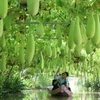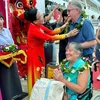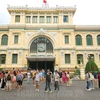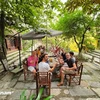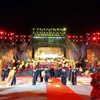 Visitors pose for a photo in front of the gate of Duong Lam village in Son Tay town, Hanoi. The gate welcomes visitors to a journey promising them an insight into a typical countryside life in the north of Vietnam. Here, both tangible and intangible cultural values intertwine to give the village the speciality that can be found nowhere else. Located more than 40 kilometres to the northwest of the capital city’s centre, Duong Lam is one of the best examples of an ancient village in Vietnam. In 2005, it became the first village recognised as a national architectural - artistic relic site. (Photo: VietnamPlus)
Visitors pose for a photo in front of the gate of Duong Lam village in Son Tay town, Hanoi. The gate welcomes visitors to a journey promising them an insight into a typical countryside life in the north of Vietnam. Here, both tangible and intangible cultural values intertwine to give the village the speciality that can be found nowhere else. Located more than 40 kilometres to the northwest of the capital city’s centre, Duong Lam is one of the best examples of an ancient village in Vietnam. In 2005, it became the first village recognised as a national architectural - artistic relic site. (Photo: VietnamPlus)  These photos were taken before the fourth wave of COVID-19 infections hit Vietnam in late April. The house where the woman poses for a photo was built in 1949 and had its parts connected with one another by a traditional method that doesn’t use iron nails. Duong Lam is an ancient village that has a history dating back about 1,200 years. Ancient houses are the most notable aspect of the village. They were built with wooden frames and fortified with laterite bricks - a special material used in construction in the Red River Delta region. There are currently a few hundreds of old houses left, with the oldest dating back 400 years. (Photo: VietnamPlus)
These photos were taken before the fourth wave of COVID-19 infections hit Vietnam in late April. The house where the woman poses for a photo was built in 1949 and had its parts connected with one another by a traditional method that doesn’t use iron nails. Duong Lam is an ancient village that has a history dating back about 1,200 years. Ancient houses are the most notable aspect of the village. They were built with wooden frames and fortified with laterite bricks - a special material used in construction in the Red River Delta region. There are currently a few hundreds of old houses left, with the oldest dating back 400 years. (Photo: VietnamPlus)  More than 40 kilometres from downtown Hanoi, Duong Lam has become a popular destination for tourists every weekend as it concurrently boasts convenient traffic, many traditional values, and a number of specialties. It has the typical features of a rural village with giant banyan trees, fresh water wells, and a communal house, along with antique houses dating back 100 to 400 years. This village was the hometown of two kings - Phung Hung (761 - 802) and Ngo Quyen (808 - 944), and also the birthplace of Envoy Giang Van Minh - an excellent diplomat in the late 16th and early 17th century. (Photo: VietnamPlus)
More than 40 kilometres from downtown Hanoi, Duong Lam has become a popular destination for tourists every weekend as it concurrently boasts convenient traffic, many traditional values, and a number of specialties. It has the typical features of a rural village with giant banyan trees, fresh water wells, and a communal house, along with antique houses dating back 100 to 400 years. This village was the hometown of two kings - Phung Hung (761 - 802) and Ngo Quyen (808 - 944), and also the birthplace of Envoy Giang Van Minh - an excellent diplomat in the late 16th and early 17th century. (Photo: VietnamPlus)  While it is hard to predict when exactly the COVID-19 pandemic will be over, one-day trips and self-drive tours of Duong Lam have become a popular choice of many families. The recognition as a national heritage site has given a strong boost to local tourism, attracting both foreign and domestic visitors. The village attracts an average of between 120,000 and 130,000 visitors, including up to 7,000 foreigners, every year. In the past, since there were not many overnight accommodation facilities available in the village, visitors often opted for short day trips. However, these days many local families have opened their doors to visitors for a home-stay experience. (Photo: VietnamPlus)
While it is hard to predict when exactly the COVID-19 pandemic will be over, one-day trips and self-drive tours of Duong Lam have become a popular choice of many families. The recognition as a national heritage site has given a strong boost to local tourism, attracting both foreign and domestic visitors. The village attracts an average of between 120,000 and 130,000 visitors, including up to 7,000 foreigners, every year. In the past, since there were not many overnight accommodation facilities available in the village, visitors often opted for short day trips. However, these days many local families have opened their doors to visitors for a home-stay experience. (Photo: VietnamPlus)  This is the entrance to the house of Ha Huu The in Mong Phu hamlet of Duong Lam commune. The wall of the house has become coloured with the time. Duong Lam, renowned for its unique houses built with wooden frames and fortified with laterite bricks, still preserves typical features of old villages in the Red River Delta. Favourable waterway transportation made Duong Lam a residence of ancient Vietnamese dating back to the Phung Nguyen (2,000 - 1,500 BC) and Dong Son (800 - 200 BC) civilisations. In a 1971 excavation, archaeologists found in Duong Lam stone relics from the Hung Kings’ era which ended in 258 BC. (Photo: VietnamPlus)
This is the entrance to the house of Ha Huu The in Mong Phu hamlet of Duong Lam commune. The wall of the house has become coloured with the time. Duong Lam, renowned for its unique houses built with wooden frames and fortified with laterite bricks, still preserves typical features of old villages in the Red River Delta. Favourable waterway transportation made Duong Lam a residence of ancient Vietnamese dating back to the Phung Nguyen (2,000 - 1,500 BC) and Dong Son (800 - 200 BC) civilisations. In a 1971 excavation, archaeologists found in Duong Lam stone relics from the Hung Kings’ era which ended in 258 BC. (Photo: VietnamPlus)  The family of Ha Huu The still preserves the traditional making of ‘tuong’, a type of fermented condiment from soya bean. No one in Duong Lam has any idea when the first soya sauce was made in the village. The sauce is made from glutinous rice, soybeans, corn and salt with the use of stone mortars, copper pans, steamers, frying pans, baskets and jars. Soy sauce makers choose their materials very carefully. They make soya sauce mostly in May and June because this time of the year is optimum for the work. Duong Lam villagers continue to make soy sauce by hand and, for them, rainwater is an indispensable ingredient (Photo: VietnamPlus)
The family of Ha Huu The still preserves the traditional making of ‘tuong’, a type of fermented condiment from soya bean. No one in Duong Lam has any idea when the first soya sauce was made in the village. The sauce is made from glutinous rice, soybeans, corn and salt with the use of stone mortars, copper pans, steamers, frying pans, baskets and jars. Soy sauce makers choose their materials very carefully. They make soya sauce mostly in May and June because this time of the year is optimum for the work. Duong Lam villagers continue to make soy sauce by hand and, for them, rainwater is an indispensable ingredient (Photo: VietnamPlus)  The soya sauce is completely made in traditional methods and contained in jars left outdoor. The jars of soya sauce have also become a magnet for visitors to the village. 'Tuong' made in Duong Lam is as famous as the one made in Hung Yen, a neighbouring province of Hanoi. Soya sauce is used in almost every meal in villages of Vietnam. People dip their boiled water morning-glory, meat and just about every kind of food in it. It’s also brushed on fish when they are fried. Soya sauce is also a necessary ingredient for many traditional dishes in the village. (Photo: VietnamPlus)
The soya sauce is completely made in traditional methods and contained in jars left outdoor. The jars of soya sauce have also become a magnet for visitors to the village. 'Tuong' made in Duong Lam is as famous as the one made in Hung Yen, a neighbouring province of Hanoi. Soya sauce is used in almost every meal in villages of Vietnam. People dip their boiled water morning-glory, meat and just about every kind of food in it. It’s also brushed on fish when they are fried. Soya sauce is also a necessary ingredient for many traditional dishes in the village. (Photo: VietnamPlus)  Each jar contains up to hundreds of litres of soya sauce, which is an indispensable souvenir once visitors come to Duong Lam. The longer the sauce is kept, the more delicious it will be. Visiting ancient houses in Duong Lam, visitors can buy this salty paste made from fermented soybean as gift. Earthenware jars containing ‘tuong’ line the yards, gently oozing a signature savory and nutty scent. ‘Tuong’ is a popular dipping sauce in northern Vietnam's countryside and also used as a condiment for cooking. Traditional cultural values, a landscape and architecture typical for the Red River Delta’s countryside, and various delicacies have made Duong Lam village an ideal tourist destination. (Photo: VietnamPlus)
Each jar contains up to hundreds of litres of soya sauce, which is an indispensable souvenir once visitors come to Duong Lam. The longer the sauce is kept, the more delicious it will be. Visiting ancient houses in Duong Lam, visitors can buy this salty paste made from fermented soybean as gift. Earthenware jars containing ‘tuong’ line the yards, gently oozing a signature savory and nutty scent. ‘Tuong’ is a popular dipping sauce in northern Vietnam's countryside and also used as a condiment for cooking. Traditional cultural values, a landscape and architecture typical for the Red River Delta’s countryside, and various delicacies have made Duong Lam village an ideal tourist destination. (Photo: VietnamPlus)  Apart from ‘tuong’, visitors to ancient houses in Duong Lam can also buy many other types of souvenirs. In the past, since there were not many overnight accommodation facilities available in the village, visitors often opted for short day trips. However, these days many local families have opened their doors to visitors for a home-stay experience. An overnight stay is exactly what people need to fully enjoy what the village offers. They can spend the day working with farmers, or enjoying traditional musical performances by the village’s artisans. All of these create an ideal tourism product, bringing in financial stability and helping the village preserve itself as a treasure in Vietnam’s unique culture (Photo: VietnamPlus)
Apart from ‘tuong’, visitors to ancient houses in Duong Lam can also buy many other types of souvenirs. In the past, since there were not many overnight accommodation facilities available in the village, visitors often opted for short day trips. However, these days many local families have opened their doors to visitors for a home-stay experience. An overnight stay is exactly what people need to fully enjoy what the village offers. They can spend the day working with farmers, or enjoying traditional musical performances by the village’s artisans. All of these create an ideal tourism product, bringing in financial stability and helping the village preserve itself as a treasure in Vietnam’s unique culture (Photo: VietnamPlus)  Vietnamese cuisine varies from one region to another, and Duong Lam village has its own list of unique local foods. ‘Keo doi’ (sausage peanut candy) and ‘keo lac’ (peanut candy) are among the most popular specialties here. It is easy to find the ingredients for making ‘keo doi’ such as peanut, malt and sugar. Once trying ‘keo doi’, visitors might feel the nutty taste of peanut and the fragrance of glutinous rice flour. Meanwhile, ‘keo lac’ is a piece of Vietnamese culture and considered one of the significant presents for visitors. Enjoying these types of sweets with some green tea will make them more flavoursome. (Photo: VietnamPlus)
Vietnamese cuisine varies from one region to another, and Duong Lam village has its own list of unique local foods. ‘Keo doi’ (sausage peanut candy) and ‘keo lac’ (peanut candy) are among the most popular specialties here. It is easy to find the ingredients for making ‘keo doi’ such as peanut, malt and sugar. Once trying ‘keo doi’, visitors might feel the nutty taste of peanut and the fragrance of glutinous rice flour. Meanwhile, ‘keo lac’ is a piece of Vietnamese culture and considered one of the significant presents for visitors. Enjoying these types of sweets with some green tea will make them more flavoursome. (Photo: VietnamPlus)  ‘Che lam’ (nutty ginger sticky rice bars) is another delicacy of locals. Aside from the original flavour, the food now also has many other tastes. The ingredients for making ‘che lam’ are ginger juice, sugar, glutinous rice flour, and peanut. The sweet is much preferred on cold days as ginger essensse can help to keep the body warm, and it is often served with a cup of hot tea. Previously, people only made ‘che lam’ for Tet (Lunar New Year holiday) or at the end of autumn, when harvest season was over and they had some spare time. But now, it is made throughout the year. (Photo: VietnamPlus)
‘Che lam’ (nutty ginger sticky rice bars) is another delicacy of locals. Aside from the original flavour, the food now also has many other tastes. The ingredients for making ‘che lam’ are ginger juice, sugar, glutinous rice flour, and peanut. The sweet is much preferred on cold days as ginger essensse can help to keep the body warm, and it is often served with a cup of hot tea. Previously, people only made ‘che lam’ for Tet (Lunar New Year holiday) or at the end of autumn, when harvest season was over and they had some spare time. But now, it is made throughout the year. (Photo: VietnamPlus)  Nowadays, residents in Duong Lam have come up with several new variants of ‘che lam’ by adding ingredients like gac fruit and pandan leaves, making it more fragrant, colorful and flavourful. This picture shows ‘che lam’ with its green colour coming from pandan leaves. The rice used to make che lam is the golden flower glutinous rice, one of best varieties in Vietnam, grown only in the north of the country. First, the rice is roasted and ground into a smooth flour. Then it is cooked with water, sugar and ginger, stirred continuously to get the mixture thick. When the mixture is still hot, peanuts are added to give it a buttery, crunchy taste. (Photo: VietnamPlus)
Nowadays, residents in Duong Lam have come up with several new variants of ‘che lam’ by adding ingredients like gac fruit and pandan leaves, making it more fragrant, colorful and flavourful. This picture shows ‘che lam’ with its green colour coming from pandan leaves. The rice used to make che lam is the golden flower glutinous rice, one of best varieties in Vietnam, grown only in the north of the country. First, the rice is roasted and ground into a smooth flour. Then it is cooked with water, sugar and ginger, stirred continuously to get the mixture thick. When the mixture is still hot, peanuts are added to give it a buttery, crunchy taste. (Photo: VietnamPlus)  Another version of ‘che lam’ with gac fruit, which features deep red colour, among its ingredients. The amount of rice flour in the mixture is important. If there is not enough rice flour, ‘che lam’ will be very sticky and soft. On the other hand, too much rice flour can make it hard as a rock. When finished, the mixture is poured onto a tray of flour to avoid it from sticking to the tray and to add more fragrance. For the pandan ‘che lam’, the leaves are boiled and the water is added when making the mixture. For ‘gac che lam’, the fruit’s flesh needs to be cooked before it is added to the mixture. (Photo: VietnamPlus)
Another version of ‘che lam’ with gac fruit, which features deep red colour, among its ingredients. The amount of rice flour in the mixture is important. If there is not enough rice flour, ‘che lam’ will be very sticky and soft. On the other hand, too much rice flour can make it hard as a rock. When finished, the mixture is poured onto a tray of flour to avoid it from sticking to the tray and to add more fragrance. For the pandan ‘che lam’, the leaves are boiled and the water is added when making the mixture. For ‘gac che lam’, the fruit’s flesh needs to be cooked before it is added to the mixture. (Photo: VietnamPlus)  All the step to make ‘che lam’ take around 10 minutes. The last thing to do is to sprinkle some roasted sesame on top. After the mixture is left to cool for an hour, it is ready to be served. A good ‘che lam’ is a little bit soft and chewy, lightly sweet and gingery, carrying the fragrant flavours of pandan or gac, along with the richness of peanuts. The unique way to make it dated back a few hundred years ago. It’s best to enjoy ‘che lam’ on a windy day, when the weather starts getting colder, with some hot green tea to go with it. (Photo: VietnamPlus)
All the step to make ‘che lam’ take around 10 minutes. The last thing to do is to sprinkle some roasted sesame on top. After the mixture is left to cool for an hour, it is ready to be served. A good ‘che lam’ is a little bit soft and chewy, lightly sweet and gingery, carrying the fragrant flavours of pandan or gac, along with the richness of peanuts. The unique way to make it dated back a few hundred years ago. It’s best to enjoy ‘che lam’ on a windy day, when the weather starts getting colder, with some hot green tea to go with it. (Photo: VietnamPlus)  It would be great regret if visitors to Duong Lam skip the local roasted pork and honey-glazed roasted chicken, which are also renowned dishes of this village. The roasted pork, traditionally on bamboo poles, has tender and juicy meat, along with incredibly brown crispy skin. Legend has it that when Ngo Quyen (897 - 944) defeated the Southern Han enemy on the Bach Dang River, the pork roasted on bamboo sticks was the dish made to give a feast to his troops. Today, this recipe is still considered a special treat that people of Duong Lam village use to welcome their friends and tourists. (Photo: VietnamPlus)
It would be great regret if visitors to Duong Lam skip the local roasted pork and honey-glazed roasted chicken, which are also renowned dishes of this village. The roasted pork, traditionally on bamboo poles, has tender and juicy meat, along with incredibly brown crispy skin. Legend has it that when Ngo Quyen (897 - 944) defeated the Southern Han enemy on the Bach Dang River, the pork roasted on bamboo sticks was the dish made to give a feast to his troops. Today, this recipe is still considered a special treat that people of Duong Lam village use to welcome their friends and tourists. (Photo: VietnamPlus)  Locals have to get up at 3am since it takes them nearly eight hours and many complicated steps to create roasted pork like this. The bacon is marinated with pepper, garlic, chillies, onion, fish sauce and chopped guava leaves. It is traditionally wrapped around a large bamboo pole lined with banana leaves inside. The pork is grilled on charcoal for 10 minutes and then will be pierced with a sharp needle to make the fat melt. After that, it is washed with salt water that is added with some lemon juice to make the skin crispy and clean. The meat is then roasted for 3 - 5 hours. (Photo: VietnamPlus)
Locals have to get up at 3am since it takes them nearly eight hours and many complicated steps to create roasted pork like this. The bacon is marinated with pepper, garlic, chillies, onion, fish sauce and chopped guava leaves. It is traditionally wrapped around a large bamboo pole lined with banana leaves inside. The pork is grilled on charcoal for 10 minutes and then will be pierced with a sharp needle to make the fat melt. After that, it is washed with salt water that is added with some lemon juice to make the skin crispy and clean. The meat is then roasted for 3 - 5 hours. (Photo: VietnamPlus)  The crunchy roasted pork in Duong Lam village has unique flavour. Taking a bite of the food, people can enjoy the super crunchy and golden brown skin of the roasted pork, which is also full of guava leaf flavour. Coming to Duong Lam Ancient Village, if visitors wish to have lunch with the locals, they can ask a house's owner and be warmly welcomed. The normal meal includes such dishes as roasted pork, stir-fried vegetables,... and ‘tuong’ - the special fermented condiment made from soya bean. After the meal, they will be invited to enjoy a tea break with ‘che lam’ or ‘keo doi’. (Photo: VietnamPlus)
The crunchy roasted pork in Duong Lam village has unique flavour. Taking a bite of the food, people can enjoy the super crunchy and golden brown skin of the roasted pork, which is also full of guava leaf flavour. Coming to Duong Lam Ancient Village, if visitors wish to have lunch with the locals, they can ask a house's owner and be warmly welcomed. The normal meal includes such dishes as roasted pork, stir-fried vegetables,... and ‘tuong’ - the special fermented condiment made from soya bean. After the meal, they will be invited to enjoy a tea break with ‘che lam’ or ‘keo doi’. (Photo: VietnamPlus)  ‘Banh te’ is another specialty of Duong Lam village. The cake can be found in other parts of Vietnam, but it is considered as the best in this village. ‘Banh te’, which literally means ‘rice cake’, is very simple. It is made from rice flour, wrapped in phrynium or banana leaves into a long, thin cylindrical shape and then steamed. The ingredients to make this dish are very easy to find in the Red River Delta region in the northern region of Vietnam, where rice farming is the main work. They are plain and non-glutinous white rice, minced pork, wood ear mushroom, onion, salt, and pepper. (Photo: VietnamPlus)
‘Banh te’ is another specialty of Duong Lam village. The cake can be found in other parts of Vietnam, but it is considered as the best in this village. ‘Banh te’, which literally means ‘rice cake’, is very simple. It is made from rice flour, wrapped in phrynium or banana leaves into a long, thin cylindrical shape and then steamed. The ingredients to make this dish are very easy to find in the Red River Delta region in the northern region of Vietnam, where rice farming is the main work. They are plain and non-glutinous white rice, minced pork, wood ear mushroom, onion, salt, and pepper. (Photo: VietnamPlus)  The hospitality of local women also adds to the attractiveness of Duong Lam village to visitors. Apart from being recognised as a national architectural - artistic relic site in 2005, Duong Lam was also named a national historical - cultural relic site in 2006, becoming the first ancient village in Vietnam to earn the title. From the centre of Hanoi, it takes one hour by bus, coach or motorbike to reach the village. Duong Lam still bears the typical features of an old Vietnamese village with a banyan tree, a wharf on the river, a village gate, a village well, courtyards of communal houses, and temples, among others. (Photo: VietnamPlus)
The hospitality of local women also adds to the attractiveness of Duong Lam village to visitors. Apart from being recognised as a national architectural - artistic relic site in 2005, Duong Lam was also named a national historical - cultural relic site in 2006, becoming the first ancient village in Vietnam to earn the title. From the centre of Hanoi, it takes one hour by bus, coach or motorbike to reach the village. Duong Lam still bears the typical features of an old Vietnamese village with a banyan tree, a wharf on the river, a village gate, a village well, courtyards of communal houses, and temples, among others. (Photo: VietnamPlus)  The COVID-19 pandemic has severely affected local residents’ livelihoods. Though there are many entrances to Duong Lam village, Mong Phu Gate remains a popular starting point for tourists. Built in the 16th century, it is located next to a 300-year-old banyan tree, a large lotus pond, and a vast rice field. This is reportedly the only ancient village gate left intact in northern Vietnam. The entrance separates the village from rice fields. Embodying ‘the village's soul’ as described by locals, it appears like a humble, rustic invitation into the village. Stepping through this gate, visitors see a narrow but clean brick-paved road leading to the centre of the village with many relics (Photo: VietnamPlus)
The COVID-19 pandemic has severely affected local residents’ livelihoods. Though there are many entrances to Duong Lam village, Mong Phu Gate remains a popular starting point for tourists. Built in the 16th century, it is located next to a 300-year-old banyan tree, a large lotus pond, and a vast rice field. This is reportedly the only ancient village gate left intact in northern Vietnam. The entrance separates the village from rice fields. Embodying ‘the village's soul’ as described by locals, it appears like a humble, rustic invitation into the village. Stepping through this gate, visitors see a narrow but clean brick-paved road leading to the centre of the village with many relics (Photo: VietnamPlus)  A well built in 1933 in Duong Lam village. Duong Lam, renowned for its unique houses built with wooden frames and fortified with laterites, still preserves typical features of old villages in the Red River Delta. In 2005, it became the first village to be recognised as a national architectural - artistic relic site. One year later, in 2006, Duong Lam was named a national historical - cultural relic site in 2006, also the first ancient village in Vietnam to earn the title. The village has long become a popular tourist destination in the capital. Every year, it attracts between an average of between 120,000 and 130,000 visitors, including up to 7,000 foreigners. (Photo: VietnamPlus)
A well built in 1933 in Duong Lam village. Duong Lam, renowned for its unique houses built with wooden frames and fortified with laterites, still preserves typical features of old villages in the Red River Delta. In 2005, it became the first village to be recognised as a national architectural - artistic relic site. One year later, in 2006, Duong Lam was named a national historical - cultural relic site in 2006, also the first ancient village in Vietnam to earn the title. The village has long become a popular tourist destination in the capital. Every year, it attracts between an average of between 120,000 and 130,000 visitors, including up to 7,000 foreigners. (Photo: VietnamPlus)  A brick path dyed in the colour of time in Duong Lam village. Laterites can be found almost anywhere in Duong Lam, becoming an integral part of the village. Laterite, the key material of walls, gates and wells, are abundant in Mong Phu hamlet, lying under fields, garden ponds, or deep down underground. The material, both a soil and a rock type rich in iron and aluminum, is often soft underground but getting harder over time once it is dug up to build houses. Houses’ walls and fences made of rough dark honey-brown brick-shaped laterites along the village road create a unique charm. (Photo: VietnamPlus)
A brick path dyed in the colour of time in Duong Lam village. Laterites can be found almost anywhere in Duong Lam, becoming an integral part of the village. Laterite, the key material of walls, gates and wells, are abundant in Mong Phu hamlet, lying under fields, garden ponds, or deep down underground. The material, both a soil and a rock type rich in iron and aluminum, is often soft underground but getting harder over time once it is dug up to build houses. Houses’ walls and fences made of rough dark honey-brown brick-shaped laterites along the village road create a unique charm. (Photo: VietnamPlus)  Gate panels made in traditional style in Duong Lam always have a handle like this. Local residents, similar to those in any rural areas in the north of Vietnam, attach great importance to the gates and communal houses of their villages as they are considered the symbols of prosperity. The most famous is the gate of Mong Phu hamlet. It was built with four pillars, which were made of four different kinds of excellent ironwoods and erected above four green stones from Quang Ninh province’s Dong Trieu village. The two panels of the gate were made of Erythrophleum fordii wood and the wall built of laterites – a special material used in construction in the Red River Delta region. (Photo: VietnamPlus)
Gate panels made in traditional style in Duong Lam always have a handle like this. Local residents, similar to those in any rural areas in the north of Vietnam, attach great importance to the gates and communal houses of their villages as they are considered the symbols of prosperity. The most famous is the gate of Mong Phu hamlet. It was built with four pillars, which were made of four different kinds of excellent ironwoods and erected above four green stones from Quang Ninh province’s Dong Trieu village. The two panels of the gate were made of Erythrophleum fordii wood and the wall built of laterites – a special material used in construction in the Red River Delta region. (Photo: VietnamPlus)  The handle on a new gate. Favourable waterway transportation made Duong Lam a residence of ancient Vietnamese dating back to the Phung Nguyen (2,000 - 1,500 BC) and Dong Son (800 - 200 BC) civilisations. In a 1971 excavation by the Institute of Vietnamese Studies and Development Science under the Vietnam National University - Hanoi and Japan’s Showa Women's University, archaeologists found stone relics from the Hung Kings’ era, which ended in 258 BC, in Duong Lam. This village was the hometown of two kings - Phung Hung (761 - 802) and Ngo Quyen (808 - 944), and also the birthplace of Envoy Giang Van Minh - an excellent diplomat in the late 16th and early 17th century. (Photo: VietnamPlus)
The handle on a new gate. Favourable waterway transportation made Duong Lam a residence of ancient Vietnamese dating back to the Phung Nguyen (2,000 - 1,500 BC) and Dong Son (800 - 200 BC) civilisations. In a 1971 excavation by the Institute of Vietnamese Studies and Development Science under the Vietnam National University - Hanoi and Japan’s Showa Women's University, archaeologists found stone relics from the Hung Kings’ era, which ended in 258 BC, in Duong Lam. This village was the hometown of two kings - Phung Hung (761 - 802) and Ngo Quyen (808 - 944), and also the birthplace of Envoy Giang Van Minh - an excellent diplomat in the late 16th and early 17th century. (Photo: VietnamPlus)  A re-created traditional-style kitchen. The combination of agriculture and tourism is not new, but for Duong Lam Village, it is a tremendous effort toward building a sustainable industry and helping locals find another source of income apart from their crops, while providing tourists with a unique experience. Duong Lam village was presented with the award of merit of the UNESCO Asia-Pacific Awards for Cultural Heritage Conservation in February 2014. A project to preserve Duong Lam village is said to have contributed to improving living conditions for local people. The successful conservation of buildings under this project has brought back the real appearance of Duong Lam village, ensuring that the structures are regularly maintained by artisans. (Photo: VietnamPlus)
A re-created traditional-style kitchen. The combination of agriculture and tourism is not new, but for Duong Lam Village, it is a tremendous effort toward building a sustainable industry and helping locals find another source of income apart from their crops, while providing tourists with a unique experience. Duong Lam village was presented with the award of merit of the UNESCO Asia-Pacific Awards for Cultural Heritage Conservation in February 2014. A project to preserve Duong Lam village is said to have contributed to improving living conditions for local people. The successful conservation of buildings under this project has brought back the real appearance of Duong Lam village, ensuring that the structures are regularly maintained by artisans. (Photo: VietnamPlus)  Taking a stroll on local paths, visitors can sometimes have a chance to see fruit-laden trees in Duong Lam. The project to preserve village was the fifth of its kind in Vietnam to receive the UNESCO award. The UNESCO Asia-Pacific Awards for Cultural Heritage Conservation was initiated in 2000 to recognise the efforts of individuals and organisations in heritage restoration and preservation. Besides, the awards had also been bestowed upon other preservation projects in Vietnam, including the lost bomb shelter at the Sofitel Legend Metropole Hotel Hanoi (in 2013), Hoi An ancient town (2000), Tang family chapel (2009), and ancient Viet house (2004) projects. (Photo: VietnamPlus)
Taking a stroll on local paths, visitors can sometimes have a chance to see fruit-laden trees in Duong Lam. The project to preserve village was the fifth of its kind in Vietnam to receive the UNESCO award. The UNESCO Asia-Pacific Awards for Cultural Heritage Conservation was initiated in 2000 to recognise the efforts of individuals and organisations in heritage restoration and preservation. Besides, the awards had also been bestowed upon other preservation projects in Vietnam, including the lost bomb shelter at the Sofitel Legend Metropole Hotel Hanoi (in 2013), Hoi An ancient town (2000), Tang family chapel (2009), and ancient Viet house (2004) projects. (Photo: VietnamPlus) VNA




